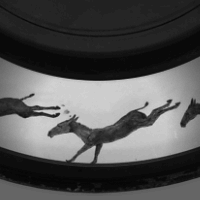Eadweard Muybridge (1830-1903, British) |
|
|
In 1872 Muybridge was challenged to provide proof that at some point in the leg movements of a galloping horse all of the legs were raised off of the ground ('unsupported transit'). He provided proof by photographing a horse running. By 1877 he developed his photographic technique by setting up a series of cameras ready to photograph a running horse. The cameras were operated by a series of trip wires which, when triggered by the horse in motion, provided a sequential set of photographs.
|
|
|
Muybridge went on to take sequential photos of many other moving animals, publishing several books with pictures of his work. In 1879 he invented the zoopraxiscope so that he could show his range of photographic studies to the public. This device, which shone light through transparent spinning disks printed (or painted) with his images, is considered to be the first movie projector.
|
|
|
Muybridge's work has provided the basic studies of movement required by animators to reproduce 'walk cycles' required for the movement of their characters to appear natural and realistic. The photos he took can be seen animated in the video below:
|
|









